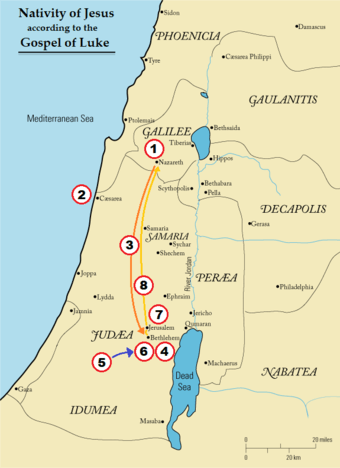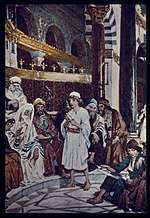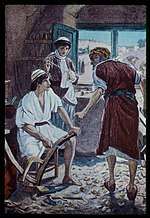Luke 2
Luke 2 is the second chapter of the Gospel of Luke in the New Testament. It contains an account of Jesus's birth and an incident from his childhood. Verses 1–19 except 2 are commonly read at Nativity plays as part of celebrating Christmas.
| Luke 2 | |
|---|---|
 Luke 2:1-7 in original King James edition showing verse 2 parenthetical. | |
| Book | Gospel of Luke |
| Category | Gospel |
| Christian Bible part | New Testament |
| Order in the Christian part | 3 |
Text

Legend: 1. Annunciation to Mary in Nazareth. 2. Census of Quirinius (historically carried out by prefect of Judea from Caesarea) 3. Joseph and Mary travel from Nazareth to Bethlehem 4. Birth of Jesus in Bethlehem 5. Annunciation to the shepherds ('nearby' Bethlehem, Luke 2:8) 6. Adoration of the shepherds in Bethlehem 7. Presentation of Jesus at the Temple in Jerusalem 8. Joseph, Mary and Jesus return home to Nazareth
The original text was written in Koine Greek. This chapter is divided into 52 verses.
Textual witnesses
Some early manuscripts containing the text of this chapter are:
- Papyrus 4 (AD 150-175; extant verses: 1; 6-7)[1]
- Codex Vaticanus (AD 325-350; complete)
- Codex Sinaiticus (330-360; complete)
- Codex Bezae (~400; complete)
- Codex Washingtonianus (~400; complete)
- Codex Alexandrinus (400-440; complete)
- Codex Ephraemi Rescriptus (~450; extant verses 1–4, 43–52)
Jesus's birth (2:1–7)

According to the Gospel of Luke, Caesar Augustus ordered a census be conducted of the ".. entire Roman World", during Quirinius's governorship of Syria and this is the reason that Joseph and Mary, who lived in Nazareth, were in Bethlehem, King David's place of birth, when Jesus was born. Many English translations suggest that the purpose of the census was for everyone to be registered, but the King James Version and others state that everyone was to be taxed.[2] The Expanded Bible explains that the register was compiled for taxation.[3]
According to the narrative in chapter 1, Mary had travelled from Nazareth to a city in the hill country of Judah to visit her cousin Elizabeth, and then returned to Nazareth,[4] then travelled again with Joseph from Nazareth to Bethlehem.
The accuracy of this date for the birth of Jesus has been disputed by many modern scholars.
The angels and shepherds (2:8–20)
Luke then tells of shepherds working nearby who are visited by an angel who tells them that in Bethlehem, the "...town of David...Christ the Lord." had been born.
Verse 10
- Then the angel said to them, "Do not be afraid, for behold, I bring you good tidings of great joy which will be to all people."[5]
Verse 11
- "For there is born to you this day in the city of David a Savior, who is Christ the Lord."[6]
"A multitude of the heavenly host" appear, praising God and saying "Glory to God in the highest, and on earth peace..." There is some discussion over the later part of the sentence the most usual modern interpretations being "... and goodwill to men", "... towards men of goodwill" or ".. to those he favours." The ASV has for example "...among men in whom he is well pleased." which corresponds to the third reading. The line is the opening part of the Greater Doxology, and as such important in the main rites of the Christian church.
The angels then return to heaven and the shepherds go into Bethlehem to see for themselves and find Joseph and Mary and the infant Jesus. They then "...spread the word..." about the angels and Jesus, then return to their flocks. It is generally considered significant that this message was given to shepherds, who were located on the lower rungs of the social ladder in first-century Palestine.[7] Contrasting with the more powerful characters mentioned in the Nativity, such as the Emperor Augustus, they seem to reflect Mary's words in the Magnificat: "He has brought down rulers from their thrones but has lifted up the humble."[8] The phrase "peace to men on whom his favor rests" has been interpreted both as expressing a restriction to a particular group of people that God has chosen[9] and inclusively, as God displaying favor to the world.[10]
Luke does not mention of the Magi, the Massacre of the Innocents, or the escape of Jesus' family to Egypt found in Matthew 2.
Circumcision and naming (2:21)

Luke 2:21 tells how Joseph and Mary have their baby circumcised on the eighth day after birth, and name him Jesus, as Gabriel had told Mary to do in Luke 1:31. Protestant theologian Jeremy Taylor argues that Jesus's circumcision proved his human nature while fulfilling the law of Moses and had Jesus been uncircumcised, it would have made Jews substantially less receptive to his Evangelism.[11]
Presentation in the Temple (2:22–38)

Verse 22
- And when the days of her purification according to the law of Moses were accomplished, they brought him to Jerusalem, to present him to the Lord;[12]
The law in Leviticus 12:1–8 requires that after giving birth of a male child, a mother is regarded as 'unclean' for seven days and to stay home for a further 33 days, after which, on the 40th day, a sacrifice is to be offered for her purification and can only be done in Jerusalem.[13] It is Mary, not her child, who needed to be purified,[13] and even though Mary was not polluted by the conception, bearing, and giving birth of Jesus, who had no impurity in his nature (although he was made sin for his people), she still came under this law of purification,[14] so that all possible requirements of the law were fulfilled (cf. Galatians 4:4).[13]
"The days of her purification" or "her purifying" (Hebrew: ימי טהרה, yə-mê ṭā-ho-rāh,[15] in Leviticus 12:4 and 12:6[14]) are to be fulfilled or accomplished following the ordination similar to the one stated by Maimonides:[16]
- a new mother does not bring her offering on the fortieth day for a male, nor on the eightieth day for a female, but after her sun is set: and she brings her offering on the morrow, which is the forty first for a male, and the eighty first for a female: and this is the day of which it is said, (Leviticus 12:6) and "when the days of her purifying are fulfilled for a son, or for a daughter, she shall bring"
This was the time when they, Joseph and Mary, brought the child Jesus, to the Temple in Jerusalem to complete Mary's ritual purification and to provide the sacrifice specified in the Law of Moses, in which she took the option provided for poor people (those who could not afford a lamb) in Leviticus 12:8, sacrificing "a pair of doves or two young pigeons."[13] This was done in the eastern gate, called the gate of Nicanor, specially for:
- women, suspected of adultery, to drink, and purified new mothers, and cleansed the lepers.[17]
Then, they presented Jesus to God through the priest, his representative. Here Mary appeared with her firstborn son, the true Messiah, marking the first time of Jesus' coming into his temple, as was foretold (Malachi 3:1).[14]
The presentation of Jesus in the Temple officially inducts him into Judaism and concludes the birth narrative in the Gospel of Luke.[18] Within the account, "Luke's narration of the Presentation in the Temple combines the purification rite with the Jewish ceremony of the redemption of the firstborn (Luke 2:23–24)."[19]
In the Temple, they meet Simeon and Anna. Simeon had been waiting for the Christ, and believes Jesus is him. Simeon prays the Nunc Dimittis (Canticle of Simeon) and tells Mary "This child is destined to cause the falling and rising of many in Israel, and to be a sign that will be spoken against, so that the thoughts of many hearts will be revealed. And a sword will pierce your own soul too." Anna, an old widowed woman who spent all her time in the temple praying, comes and praises Jesus as well.
Return to Nazareth and early childhood (2:39–40)
In verses 39-40 the family return to Nazareth in Galilee, where Jesus grows and becomes strong and wise. He receives God's favour or grace. Unlike the apocryphal gospels, no preternatural stories of Jesus childhood are found in Luke, or indeed any of the four canonical gospels. Verse 40 is echoed in verse 52.
Boy Jesus at the Temple (2:41–50)

The Gospel then provides the only story of Jesus's childhood in the Canonical Gospels. When Jesus is twelve his family travels to Jerusalem for the Passover festival. Then they leave with a large group of their relatives and friends and after a day they realize Jesus is not with them. They go back to Jerusalem and after three days of looking find him in the temple talking with the temple teachers. His parents scold him for running off, but Jesus replies that they should have known where he was. "Didn't you know I had to be in my Father's house?". His family doesn't understand what he is talking about. They all then go to Nazareth.[20]
Later childhood and youth (2:51–52)

Jesus continues to grow and flourish both in wisdom and stature, and in the favour of God and man. This mirrors verse 40, and completes Jesus' early years. The next we see of him is in Chapter 3, verse 21, when he is baptised by John the Baptist.
See also
- Gloria in excelsis Deo
- Migdal Eder ("Tower of flock")
- Pidyon haben
- Related Bible parts: Micah 4, Micah 5, Matthew 2
References
| Wikimedia Commons has media related to Gospel of Luke - Chapter 2. |
- Aland, Kurt; Aland, Barbara (1995). The Text of the New Testament: An Introduction to the Critical Editions and to the Theory and Practice of Modern Textual Criticism. Erroll F. Rhodes (trans.). Grand Rapids: William B. Eerdmans Publishing Company. p. 96. ISBN 978-0-8028-4098-1.
- BibleGateway.com, Translations of Luke 2:1
- Luke 2:1 EXB
- Luke 1:39-40, 56
- Luke 2:10 NKJV
- Luke 2:11 NKJV
- Green, p. 130.
- Luke 1:52, NIV (BibleGateway).
- Marshall, p. 112.
- Green, p. 137.
- "But so mysterious were all the actions of Jesus, that this one [his circumcision] served many ends. For 1. It gave demonstration of the verity of human nature. 2. So he began to fulfill the law. 3. And took from himself the scandal of uncircumcision, which would eternally have prejudiced the Jews against his entertainment and communion. 4. And then he took upon him that name, which declared him to be the Savior of the world; which as it was consummate in the blood of the cross, so it was inaugurated in the blood of circumcision: for "when eight days were accomplished for circumcising of the Child, his name was called Jesus." - Taylor, Jeremy. The Whole works; with an essay biographical and critical, Volume 1 (1657). Frederick Westley and A.H. Davis, London, 1835. p. 51
- Luke 2:22 KJV
- Carson et al. 1994, p. 985.
- Gill, John. Exposition of the Entire Bible. Luke 2:22. Accessed 29 June 2019.
- Hebrew Text Analysis: Leviticus 12:4. Biblehub.com
- Maimon. Hilch Mechosre Cappara, c. 1. sect. 5.
- Misn. Sota, c. 1. sect. 5.
- Porter, J. R. (1 September 1998). The Illustrated Guide to the Bible. Oxford University Press. p. 157. ISBN 9780195214628. Retrieved 27 December 2016.
The story of the Presentation of Jesus to God in the Temple concludes Luke's birth narrative (Luke 2.22–39).
- Perlove, Shelley; Silver, Larry (2009). Rembrandt's Faith: Church and Temple in the Dutch Golden Age. Penn State Press. p. 191. ISBN 9780271048383.
- The Bible Knowledge Commentary: New Testament edition by John F. Walvoord, Roy B. Zuck 1983 ISBN 0-88207-812-7 p. 210
Further reading
- Brown, Raymond E. An Introduction to the New Testament 1997 Doubleday ISBN 0-385-24767-2
External links
- Luke 2 King James Bible - Wikisource
- English Translation with Parallel Latin Vulgate
- Online Bible at GospelHall.org (ESV, KJV, Darby, American Standard Version, Bible in Basic English)
- Multiple bible versions at Bible Gateway (NKJV, NIV, NRSV etc.)
| Preceded by Luke 1 |
Chapters of the Bible Gospel of Luke |
Succeeded by Luke 3 |
.jpg)